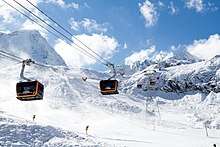Tricable gondola lift
The tricable gondola lift, also known as the 3S gondola lift, is a cable car system that was developed by the Swiss company Von Roll transport systems in Thun to unite the benefits of a gondola lift with those of a reversible cable car system. ‘3S’ is an abbreviation of the German word dreiseil, meaning ‘tricable’.


History
The first plant of this type, called Alpine express I, was built in 1991 in Saas-Fee. In 1994, a further section, called Alpine express II, became operational, although a continuous service of both sections is not possible. The cabins of these plants have space for 30 persons and travel with a speed of 6 m/s pulled by an endless hauling cable, and suspended from two carrying cables.
A lane thus consists of three cables (from which the system takes its name). As with most rotating cabin cableways, gondolas are detachable from the cables in order to allow easy disembarkation without disrupting the transit of other cars on the system. The system offers the following advantages over less sophisticated aerial cable-driven transportation systems:
- lower energy consumption compared with to-and-from system aerial ropeways of similar capacity
- increased wind stability compared with conventional (monocable) gondola lifts
- larger ground distances and rope spans are possible compared with conventional gondola lifts
- high driving speed in relation to unity express orbits: Speeds over 8 m/s are possible
- high passenger capacity and comfort compared with conventional reversible cable car systems
- more frequent departures compared with conventional reversible cable car systems
Development and building of the Alpine express I cost 70 million SFr. Von Roll built no more 3S cable cars after the two systems in Saas Fee. When Von Roll was acquired by the Austrian company, Doppelmayr, in 1996, Doppelmayr attained the know-how for 3S cable car construction.
The Italian company, Leitner, has also, since then, developed a 3S cable car system.
Installations
Kitzbühel
The 3S cable car in Kitzbühel, Austria bridges the Saukasergraben and connects the skiing areas of Kirchberg and Resterhöhe with one another. The lift opened in January 2005 and is 3,642 metres long. A journey takes approximately nine minutes from end to end. At its highest point, the cableway is 400 metres from the ground. The use of only one aerial lift pylon resulted in an unusual span width of 2,507 metres between the valley station and the 80-metre support pillar. Overall, the system cost 13.5 million euros with each cabin costing 100,000 euros.
The cableway was manufactured by Doppelmayr. The cable of the 3S cable car has a diameter of 54 millimetres. The electrical power consumption is 400 kW.
There are 19 cabins in total, though the system can be expanded to 24 cabins if the need arises in the future. Each cabin seats 24 people, allowing the system to transport a total of 3200 people in any given hour. One cabin has a glass floor, making it possible to view the 400 metre drop from a different angle.
Peak 2 Peak Gondola
In December 2008, Whistler-Blackcomb ski resort in British Columbia became the first North American resort to install a 3S cable car ("aerial tramway" in the US) when it opened the Peak 2 Peak Gondola, which connects Roundhouse Lodge on Whistler with Rendezvous Lodge on Blackcomb. In effect, it is like the Kitzbühel 3S cable car because it connects two ski areas (although in this case, more two parts of the same area together). The installation of the Peak 2 Peak Gondola eliminated the need to use the base area gondolas to get between Whistler and Blackcomb, connecting the areas together.
References
External links

- Doppelmayr 3S Gondola Lifts
